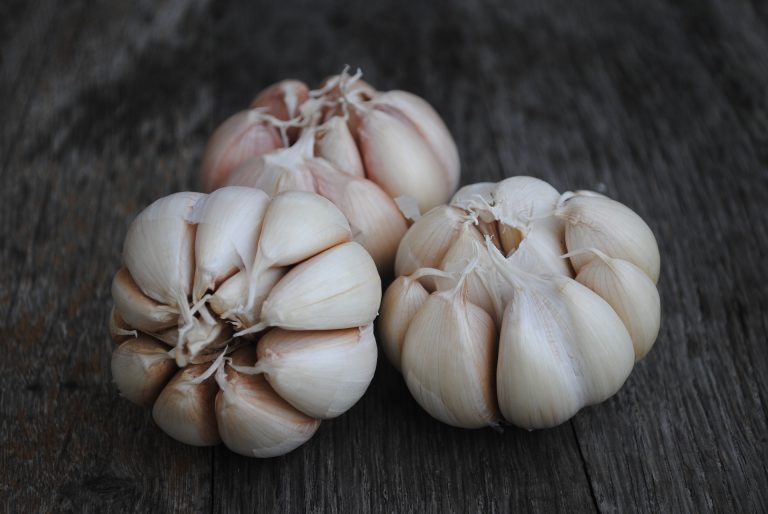Introduction
Garlic (Allium sativum) stands as one of humanity’s oldest cultivated plants, revered not only for its culinary contributions but also for its medicinal properties and cultural significance. Throughout history, this bulbous herb has found its way into kitchens, apothecaries, and folklore around the world. From ancient remedies to modern scientific studies, garlic continues to captivate with its multifaceted uses and health benefits.

Historical and Cultural Significance
Ancient Origins and Spread
Garlic’s origins can be traced back over 5,000 years to Central Asia, where it was likely first domesticated. From there, it spread through trade routes to ancient civilizations in Egypt, Mesopotamia, and India. Historical records, including those from the ancient Egyptians who revered garlic, document its use as food, medicine, and even as a religious offering.
Garlic in Mythology and Folklore
Across cultures, garlic has woven itself into mythology and superstition. In Greek mythology, garlic was said to grow from the blood of the goddess Hecate, while in Slavic folklore, it was believed to ward off vampires and evil spirits. Its pungent odor and potent properties made it a symbol of both protection and strength.
Botanical Features and Culinary Uses
Botanical Characteristics
Garlic belongs to the Allium genus, which includes onions, leeks, and chives. It is characterized by its bulb, consisting of cloves encased in a papery sheath. Each clove contributes to the overall flavor profile of garlic, which can range from mild and sweet when raw to deeply savory when roasted or sautéed.
Culinary Applications
In culinary traditions worldwide, garlic is a staple ingredient prized for its ability to enhance flavors. Whether minced, crushed, sliced, or roasted, garlic adds complexity and depth to dishes ranging from Italian pasta sauces to Asian stir-fries. Its versatility extends to being used fresh, dried, or as a powder, ensuring its presence in kitchens globally.

Medicinal Properties and Health Benefits
Traditional Medicinal Uses
Throughout history, garlic has been admired for its medicinal properties. Ancient civilizations used it to treat a wide range of ailments, from infections to digestive disorders. Traditional Chinese medicine and Ayurveda continue to incorporate garlic into treatments for its purported antimicrobial, anti-inflammatory, and immune-boosting effects.
Modern Scientific Research
In recent decades, scientific interest in garlic has surged, leading to numerous studies validating its health benefits. Garlic is rich in sulfur compounds, notably allicin, which is released when cloves are crushed or chopped. Allicin is credited with antibacterial, antiviral, and antifungal properties, making garlic a potential ally in combating infections.
Cardiovascular Health
One of garlic’s most studied benefits is its potential to support cardiovascular health. Research suggests that regular consumption of garlic may help lower blood pressure, reduce cholesterol levels, and improve circulation, thereby reducing the risk of heart disease and stroke.
Antioxidant and Anti-inflammatory Effects
Garlic’s antioxidant properties help neutralize free radicals in the body, potentially reducing oxidative stress and inflammation. These effects are thought to contribute to its broader health benefits, including potential protection against certain cancers and age-related diseases.
Culinary and Medicinal Practices Around the World
Regional Variations in Garlic Usage
The cultural significance of garlic manifests in diverse culinary traditions. In Mediterranean cuisine, garlic plays a central role in dishes like aioli and tzatziki. In East Asian cooking, it flavors stir-fries and marinades. Each region has developed unique methods of preparation and pairing, showcasing garlic’s adaptability across different culinary landscapes.
Medicinal Practices and Remedies
Traditional remedies featuring garlic continue to be passed down through generations. From garlic-infused oils for earaches to poultices for wound healing, these practices highlight garlic’s enduring role in folk medicine. Modern integrative medicine incorporates these remedies alongside scientific findings, illustrating a blend of ancient wisdom and contemporary research.

Growing and Harvesting Garlic
Cultivation Techniques
Garlic thrives in well-drained soil and requires ample sunlight. It is typically propagated by planting individual cloves, each of which develops into a new bulb. Different varieties exhibit variations in size, flavor intensity, and storage capabilities, influencing their culinary and medicinal applications.
Harvesting and Storage
Garlic is harvested when the leaves begin to yellow and wither, typically in late summer or early autumn. Proper curing and storage conditions are crucial to preserve its flavor and medicinal properties. Home gardeners and commercial growers alike employ techniques such as drying and storing bulbs in cool, dry environments to maintain garlic’s quality.
Contemporary Issues and Future Directions
Sustainability and Agricultural Practices
As global demand for garlic continues to rise, sustainable farming practices are becoming increasingly important. Issues such as soil depletion, pesticide use, and climate change pose challenges to garlic cultivation. Efforts are underway to promote organic farming methods and genetic diversity in garlic varieties, ensuring its availability for future generations.
Research Frontiers
Ongoing research explores new applications for garlic compounds in fields such as pharmacology and biotechnology. Advances in understanding garlic’s biochemical properties could lead to innovations in drug development, functional foods, and agricultural biotechnology. These developments promise to further unlock the potential of garlic beyond its traditional uses.

Conclusion
Garlic’s journey from ancient remedy to modern-day culinary staple is a testament to its enduring appeal and remarkable versatility. As scientific research continues to uncover its health benefits and culinary potential, garlic remains a symbol of resilience and adaptation in the face of changing times. Whether minced in a sauce, brewed in a potion, or planted in a garden, garlic continues to inspire and enrich the lives of people around the world.
Through its rich history, botanical intricacies, and multifaceted uses, garlic stands as a testament to the enduring relationship between humans and the natural world—a relationship rooted in discovery, innovation, and the quest for both nourishment and healing.
As we look ahead, the story of garlic unfolds with new chapters yet to be written, promising continued exploration and appreciation for this humble yet extraordinary herb.

